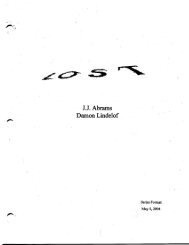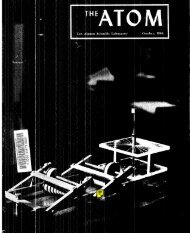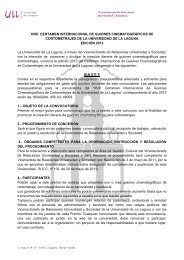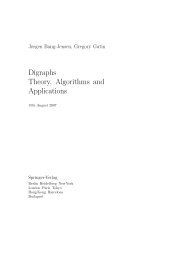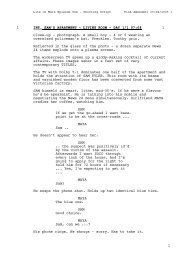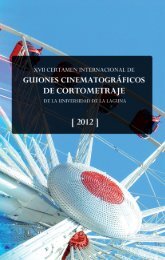Create successful ePaper yourself
Turn your PDF publications into a flip-book with our unique Google optimized e-Paper software.
y r = 6l.Now we have to find the numbers xo and yo with<br />
similar properties.<br />
To find x7., let's square xo _ , and take the last k digits<br />
of this square/ so thatx?_ r = 10ka +xo. Let's show that<br />
*i - *t is divisible by 10k:<br />
,?-rt =l"?_,-lokalz-("?_, - loka)<br />
= *X_r-2axl_, . 100 + IO*a2 -*?_r+ lOka<br />
: (" ? _ r- xk _, )(r?_, * x1_ 1)<br />
+ 10kl 10ka2 + a - Zax f; - 1lr.<br />
But xo2_ r - xft - r is divisible by lG- 1, and x | _, + xo _, is<br />
divisible by 10 (since both xo_, and xo2_, end in 5).<br />
Therefore, both terms in the last expression are divisible<br />
by 10k.<br />
The construction of yo is a bit more complicated: we<br />
have to take the last k digits of yf _ r. the divisibility<br />
of yk2 - lr7. by 10k is proved in almost the same way:<br />
v? -vx:bf -r-tokblz -(vf -1- lokbl<br />
= b ? -, - vt )lv f -, + Y I - r + Y f - r+ rf- r<br />
+ v f - tl+<br />
lOk c,<br />
where c:tOkb2 +b-zbyf_,. Thetermyos_ r+ ...+yf_r<br />
is divisible by 10 because it's the sum of five numbers<br />
ending in6, andthe differencey?_r-yt _, is divisible<br />
by 1Or - 1<br />
by the induction hypotheiis. So yo2 - yo is divisible<br />
by 10k, and we're done.<br />
Implim[ions<br />
From the first proof, we can see that the sum of the<br />
third and fourth numbers we've found is equal to 10& +1<br />
(indeed, 25 + 76 = 101, 625 + 376: 1,001).<br />
Exercise 1. Prove that this is true for allk.<br />
The second proof demonstrates one arnazing fact:<br />
the fourk-digit endings that are preserved under squaring<br />
are obtained from the respective (k - 1)-digit endings<br />
preserved under squaring merely by adding one<br />
digit on the left! Indeed, the lastk - 1 digits ofxo coincide<br />
with those of x|_r, and so they constitute xo_ r;<br />
only the kth digrt from the right in xo is new. In a similar<br />
argument for the y's we must use the fact that yo _,<br />
comprises the last k - 1 digits of y f _,: this follows from<br />
the identity y<br />
f - t - y * _ r : (V ? _, - y x _ rl(y x _ r + 1 )( yo2_, + 1 )<br />
and the divisibility of y ? _ r - yt _, by 10k - 1.<br />
You may<br />
have noticed this already in our numerical examples:<br />
0-00-000-...,<br />
1-01-001-...,<br />
5-25-625-...,<br />
6-75-375-....<br />
Thus, in the sequence 5,25, ..., xk_r, xk,... , the<br />
terms are built up by adding digits on the left end; this<br />
is also true of the sequence 6,76, ... ,yk_1, yp, .... If we<br />
don't interrupt this process, it will yield two infinite<br />
"numbers"; with ten digits written out they are<br />
x: ...82t289062s,<br />
Y = ...1787t09376.<br />
We cautiously put the word "numbers" in quotation<br />
marks, but, as we'll see in a while, these infinite sequences<br />
can quite legitimately be granted the status of<br />
genuine, though somewhat unusual, numbers.<br />
A new kind olnumhel'<br />
We need a name for our inIinite-to-the-1eft sequences<br />
of digits ...a4azazar. Let's call them supetnumbers.Il<br />
all the digits in such a sequence starting from a certain<br />
place are zeros, we'll say that this supernumber is an<br />
ordinary number-for instance,<br />
...000132 : t32.<br />
Thus, among supemumbers one can find all ordinary<br />
nonnegative integers, but other "numbers" as well.<br />
Supernumbers can be added and multiplied using the<br />
ordinary digit-by-digit rules (fig. 1). They resemble infinite<br />
decimals, as if they were reflected through the<br />
decimal point, except that because of the "carry," the<br />
rules for performing operations are not reflected. This<br />
makes them an essentially new algebraic object. However,<br />
for ordinary supernumbers these operations are<br />
our usual addition and muitiplication. It's interesting<br />
that supernumbers can be subtracted from one another<br />
in any order, also in the usual digit-by-digit way-see<br />
figure 2. (The relation " greaterf srnaLler" cart't be introduced<br />
for supernumbers so as to agree with the algebraic<br />
operations as it does for ordinary numbers.) In<br />
partiatlar, any supernumber can be subtracted from<br />
zero (the supemumber ...000). Therefore, all ordinary<br />
negative numbers can also be found among<br />
supernumbers. For example, figure 3 illustrates the<br />
equality -132 = ...999858. We can see that "ordinary<br />
negative integers" are simply supernumbers with an<br />
infinite row of 9's to the left.<br />
Addition and multiplication of supernumbers, and<br />
subtraction as well, have the usual properties of these<br />
operations: a + b = b + a, ab = ba, a + (b + cl : (a + bl + c,<br />
a(bcl = lablc, a{b + cl = ab + ac, arld so on. In particular,<br />
for arry supemumberxwe can calculate the supemumber<br />
* - ,, and our theorem immediately tells rs that the<br />
a<br />
Figure 1<br />
.... _.6847<br />
+.... ..4219<br />
..._..t066<br />
......6847<br />
x.... ..4219<br />
......t623<br />
......6847<br />
......3694<br />
...... 7388<br />
7493<br />
......2628<br />
Figure 2<br />
4219<br />
6847<br />
.7372<br />
l8<br />
JUtY/AlJEUSI lgS4



